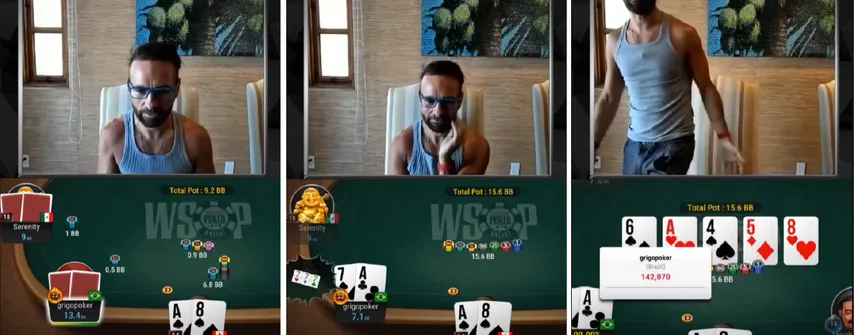Let's do a hand breakdown from the recent win that I had.
Well, the first event of the year, going to go over a few of the key hands. We went over one in the last video where we made a good fold on the river, and in this one, we are going to do a funky bluff.
There are four players remaining in this tournament. You know, one of the things you think about at the final table is ICM considerations. Probably one of the biggest advancements with the younger generation is just the depth of understanding of where you sit and how you should play as a result.
Daniel's Funky Bluff Against Smiljkovic
In this hand, I'm set up actually in a spot against a player who I know is a studied player (Smiljkovic), and he's sitting in second place and I'm sitting third.
He has me covered by just a little bit, but I'm not an ICM pushover. I'm not somebody who shies away from fighting for spots. I think that makes me a little bit more difficult to play against, you know, maybe it leads to a few more like ICM punts (like the one we are about to show you in a second), and I don't really care. I'm going for the win from the get-go.

On a YouTube Short posted to the GGPoker official channel, we get to see one of the most brutal ICM punts from Daniel. It's an Online WSOP $2,500 event, and about 150 players remain out of 1061 entries.
He shoves , gets called by , and then gets a nightmarish runout.
Daniel flops the world on a board, while his opponent just has top pair and a backdoor straight draw.
The turn is the , and the river is a punishing , giving his opponent a straight.

Forget blockers.
Forget outs.
Forget equity.
Sometimes, the poker gods just want to laugh a little. At least GG had the sense of humor to post the clip.
So, this hand, it's 40,000 and 80,000 blinds. Smiljkovic — we're going to call him Smiley, okay?
Smiley raises to 160,000, a min-raise, from under the gun (UTG). In a four-handed game, it's the cutoff as well. We're in the big blind, and we have the .
So, off of our stack size here, it's a pretty easy hand to defend. You're not folding this four-handed, especially with the big blind ante. Even if you were off-suit here, you're probably going to call, and take a flop unless there are some extreme ICM considerations. Like, you wouldn't play if the fourth player has two big blinds left; you just have to bow to the chip leader.

That's what you see a lot in these final tables, is a lot of bowing. Everyone says, okay, you're Mr. Chip Leader, I'm sitting here in third, there's two guys ready to go broke, I'll wait.
So, we make the call with the .
To the Flop!
And the flop is the .
So, we have a grand total of nothing. I don't know what to say. Alright, I check, which is, you know, customary in the situation, and Smiley bets 125,000. So, he's betting about a quarter pot. Right, again, so far, so good; everything reasonable.
Now, the question is, with our hand, what to do next? Well, we don't have anything, but we have a lot of perceived equity here.

We have a couple of three-card straight draws
- We have
- We have .
We've also got the backdoor draw. So, we have some backdoor potential. Now, I think it's probably too much equity to just check-fold here, although you could make a case for that, even against a small bet. I think it's also a spot where you could peel and potentially set up some bluffs on a check-check turn.
So, let's say you check-call the flop, the turn is check-check, and then the river is a queen. Well, now you can go ahead and bet with your Jack-high. You're blocking some , you know, it's very reasonable you have a . All these types of hands you can sort of represent. There's not a lot that peeled the flop that is now a bluff, so that's one way to play it, right?
The other way is to check-raise.

You have to have some check-raises on flops sometimes because sometimes you're going to want to check on this board with , , . You're going to want to check some of your strong hands, and if you're only doing that with your strong hands, well, then you're not going to get the action that you deserve or that is warranted for such a hand.
So, you have to have some bluffs, and when constructing bluffs, it's a good idea to construct bluffs that can turn into higher equity barrels on the turn. So, with our , there are a decent number of turn cards we could turn where we could continue the story that we're telling, right, and fire a second barrel.
If we had here, I think it's just a fold because we don't have that backdoor flush draw, right?
So, here's the thing, the stack depths, you know, we're not that deep. You know, it is a final four situation, so the raise size on this doesn't have to be crazy big. You can throw in some bigger raises here, but you can also have a decent number of relatively small raises.
So, he bets 125,000. I like to go small, raising to just 365,000, so it's another 240,000 for him to call, and I expect him to call a decent amount.
If I pick up a good turn card, maybe we'll continue the story.

However, on this flop, let's say he just had , it just folds. If he has , he's just going to fold a lot.
He's not necessarily going to continue with a lot of his weaker holdings, right? He's going to peel with his gut shots, he's going to peel with any pair, some backdoor stuff as well, but we block a little bit of that, as I said. So, a decent number of times, you're going to actually win this on the flop, and when you don't, again, you can still set yourself up well for the turn.
Does the Turn Help the Canadian Pro?
On the turn, we have a pot of 1.17 million in there. Here's the dilemma: the turn is the , so we've turned the flush draw, right?
As I said, there's going to be a decent number of cards that give us some higher equity situations. If he has a , I don't expect him to fold. If I bet the turn, i expect him to fold his gut shots, his Ace-high type hands, and the like.

So, the question is, how much to bet? Now, if you bet too much, right, you're going to be forced to call the raise sizing all in because you're going to be priced in. So, this is a spot on this turn card, with a double monotone board or the double flush draw board, I think you can incorporate some less than half-pot sizing, probably one-third pot-ish, but I go for 475 into 1.17 million.
I thought about this one for a while. I took about a minute. My thinking was, I don't want to commit myself with this bet size, and I also don't necessarily want to make it easy for him to peel to the river and put me in a difficult spot where I might have to just fire the third barrel if we miss.
So, I go for the 475,000.
He folds his , and we win.

Okay, so, you know, we're lucky he didn't have anything. He didn't have a here, but even if he did, he probably doesn't raise a here very often, not if it's just a regular . Like, if he just had suited or something like that, he's probably just calling, and he's going to let us try to bluff it off on the river.
So, for that 475,000, we're sort of giving ourselves our own price. If he does call, to hit that flush, we're not getting a good price, you know. We're not getting the right price, but when you factor that in with the fold equity that we have with the bet, as well as a size that allows us to still bluff rivers, right?
What rivers would we bluff? Well, we'd probably have to bluff some , , rivers, right? We probably have to bluff, frankly, even without a in our hand because that is a reasonable holding for us to have. So, those would be the kind of cards we bluff. We probably are not going to be bluffing an , you know, but a , , , or , those would be our bluff cards.
The is our payoff card, obviously. If we hit that, we would just, you know, be betting for value.
But the idea here is that you're fighting for flops, and when you do so, you want to do so with your strong hands. You want to do so with some of your bluffs, but when you are choosing bluffs, choose bluffs that have some blocker effects and also have some backdoor equity. Those are the better ones to choose, rather than say bluffing here with, like, you know, . Like, well, what turn card am I going to hope for if I have that's going to give me a chance to bluff this turn or give myself an opportunity to actually develop some equity?
There isn't one.
So, falls into that category. The check-raise worked. A little bit of aggressive play, you know, He's c-betting every flop, right? So, you can't just let somebody c-bet you to death and then only raise them with good hands. You've got to push back a little bit and bluff, especially as you get short-handed and you get deeper in the tournament. You have to factor this in as well, thinking of ICM, where your chip stack is, and if your chip stack is in some spots, you have to be risk-averse, like if there's 2 or 3 BB stacks.
But in other cases, you're the one who can push the pedal to the metal, and that's something to always be thinking about at a final table.
For me, it was this hand. We did so, and we succeeded. Mission accomplished.
– Don't feel too bad for Daniel Smiljkovic. He won the PGT $1 Million Freeroll and took home $500,000.






